Communication Network Architectures Based on Ethernet Passive Optical Network for Offshore Wind Power Farms
Abstract
:1. Introduction
- Propose communication network architectures for WPF monitoring based on EPON technology;
- Configure the network model of small-scale WPFs, based on electric power topologies;
- Analyze the optical power budget and path loss to ensure that the received signal power at the wind turbines side is sufficient to maintain acceptable performance;
- Make a reliability analysis of the communication network, consisting of OLT, feeder fiber (FF), passive optical splitter (POS), distributed fiber (DF), and ONU;
- Compare the connection availability between OLT and WT-ONUs with different protection schemes; and
- Compare the network costs for 20 different architectures with, and without, protection schemes.
2. Related Work
2.1. Communication Network for Wind Power Farms (WPFs)
- Inside the turbine tower, including the wind turbine controller (WTC), remote terminal units (RTU), intelligent electronic devices (IEDs), and sensors. The WTC collects all data using short communication links, and makes them available for processing and transferring to the control center. The closed-circuit television (CCTV) system and the Internet connection may share or use an independent communication network between the wind turbine and the control center.
- Communication network based on Ethernet equipment (gigabit Ethernet switch) is considered, to transfer data between the WTs and the control center. Most WPFs use the same power cable routes for the SCADA communication network as for the power distribution.
- Control center connects individual WTs and meteorological stations to the control center. It enables the operators to manage the behavior of all WTs as a whole. It requires a long distance for data transmission.
2.2. Ethernet Passive Optical Network (EPON)-Based Communication Network for WPFs
3. Proposed EPON-Based WPF Topologies
- An OLT is installed in the control center;
- Each WT has only one ONU device;
- All internal networks inside a WT (which include monitoring, protection, and security) may be connected with one or more ONU buffers; and
- Different network architectures are designed, using FF, DF, and POS.
3.1. Architecture (A)
3.2. Architecture (B)
3.3. Architecture (C)
3.4. Architecture (D)
3.5. Architecture (E)
4. Performance Evaluation
4.1. Optical Power Budget
4.2. Reliability
- The WTs used in this study are 5 MW. The distance between two WTs is 1 km.
- Reliability analysis considers only the communication network between the OLT and ONUs. It consists of OLT, FF, POS, DF, and ONU.
- We assume that the failure rate of the OLT and ONU is small, compared with the number of failures in cables. Therefore, the equipment failures of OLT and ONUs are neglected in our analysis.
- The communication network equipment inside each WT is not considered, and only the ONU is considered in our calculation.
4.2.1. Reliability Block Diagram
4.2.2. EPON-based Protection Schemes
4.3. Network Cost
5. Conclusions
Acknowledgments
Author Contributions
Conflicts of Interest
References
- Zaker, N.; Kantarci, B.; Erol-Kantarci, M.; Mouftah, H.T. Smart grid monitoring with service differentiation via EPON and wireless sensor network convergence. Opt. Switch. Netw. 2014, 14, 53–68. [Google Scholar] [CrossRef]
- Raza, A.; Ullah, K.; Ahmed, S.; Hyuk-Soo, J.; Hyo-Sik, Y. Baseline Efficiency in EPON Based Architecture to Inter-Network Substations. In Proceedings of the IC4 2009: 2nd International Conference on Computer, Control and Communication, Karachi, Pakistan, 17–18 February 2009; pp. 1–6.
- Jiang, H.; Yao, J.; Zhang, G. The construction scheme analysis of distant communication systems for subscriber power consumption information acquisition systems. J. Int. Counc. Electr. Eng. 2011, 1, 482–485. [Google Scholar] [CrossRef]
- Yao, H.; Peng, Q.; He, W.; Zhang, X. Integrated Communication Technology for Supervisory Control and Data Acquisition System of PV Power Station. In Proceedings of the ISDEA 2012: 2nd International Conference on Intelligent System Design and Engineering Application, Sanya, China, 6–7 January 2012; pp. 1277–1280.
- Kanabar, M.; Sidhu, T.S. Reliability and Availability Analysis of IEC 61850 Based Substation Communication Architectures. In Proceedings of the IEEE PES Power and Energy Society General Meeting 2009, Calgary, AB, Canada, 26–30 July 2009; pp. 1–8.
- Ali, I.; Thomas, M.S.; Gupta, S.; Hussain, S.M.S. IEC 61850 substation communication network architecture for efficient energy system automation. Energy Technol. Policy 2015, 2, 82–91. [Google Scholar] [CrossRef]
- Franken, B. Reliability Study. Analysis of Electrical Systems within Offshore Wind Parks, Elforsk Report 07:65; Elforsk: Stockholm, Sweden, November 2007; Available online: http://www.elforsk.se/Global/Vindforsk/Rapporter%20fran%20Vindforsk%20II/V-118%20R_07_65.pdf (accessed on 10 January 2016).
- Gardner, P.; Craig, L.M.; Smith, G.J. Electrical Systems for Offshore Wind Farms. In Proceedings of the European Wind Energy, 20th BWEA Conference, Cardiff, UK, 2–4 September 1998; pp. 1–9.
- Pettener, A.L. SCADA and Communication Networks for Large Scale Offshore Wind Power Systems. In Proceedings of the RPG 2011: IET Conference on Renewable Power Generation, Edinburgh, UK, 6–8 September 2011; pp. 1–6.
- Ahmed, M.A.; Kim, Y.C. Communication network architectures for smart-wind power farms. Energies 2014, 7, 3900–3921. [Google Scholar] [CrossRef]
- Maier, M.; Ghazisaidi, N. QoS provisioning techniques for future fiber-wireless (FiWi) access networks. Future Internet 2010, 2, 126–155. [Google Scholar] [CrossRef]
- Ahmed, M.A.; Yang, W.H.; Kim, Y.C. Communication Network Architectures Based on EPON for Offshore Wind Power Farm. In Proceedings of the ENERGY 2013: 3rd International Conference on Smart Grids, Green Communications and IT Energy-aware Technologies, Lisbon, Portugal, 24–29 March 2013; pp. 15–20.
- Kramer, G.; Pesavento, G. Ethernet passive optical networks (EPON): Building a next-generation optical access network. IEEE Commun. Mag. 2002, 40, 66–73. [Google Scholar] [CrossRef]
- Kantarci, B.; Mouftah, H.T. Bandwidth distribution solutions for performance enhancement in long‐reach passive optical networks. IEEE Commun. Surv. Tutor. 2012, 14, 714–733. [Google Scholar]
- McGarry, M.P.; Reisslein, M. Investigation of the DBA algorithm design space for EPONs. J. Lightwave Technol. 2012, 30, 2271–2280. [Google Scholar]
- Li, X.; Dan, L.; Wu, Q. Adaptive dynamic bandwidth allocation algorithm supporting multi-services over Ethernet passive optical networks. Opt. Int. J. Light Electron Opt. 2013, 124, 287–291. [Google Scholar]
- IEEE Standard 802.3ah, IEEE‐SA Standard Board, June 2004. Available online: http://www.ieee802.org/21/doctree/2006_Meeting_Docs/2006-11_meeting_docs/802.3ah-2004.pdf (accessed on 10 January 2016).
- Ng, B.; Syuhaimi, M.; Premadi, A.; Jumari, K. Optical power budget and cost analysis in PON-based I-FTTH. Res. J. Inf. Technol. 2010, 2, 127–138. [Google Scholar] [CrossRef]
- Huang, H.; Zhang, H. Application and analysis of long distance EPON in transmission lines monitoring system. Adv. Mater. Res. 2011, 317–319, 1583–1589. [Google Scholar] [CrossRef]
- Chen, J.; Kantor, M.; Wajda, K.; Wosinska, L. Next-Generation FTTH Passive Optical Networks: Research towards Unlimited Bandwidth Access; Prat, J., Ed.; Springer: Dordrecht, Netherlands, 2008. [Google Scholar]
- Kourtessis, P; Almeida, C.; Chang, C.H.; Chen, J.; Di Bartolo, S.; Fasser, P.; Gagnaire, M.; Leitgeb, E.; Lima, M.; Löschnigg, M.; et al. Evolution of Optical Access Networks. In Towards Digital Optical Networks; Springer: Berlin, Germany, 2009; Volume 5412, pp. 97–131. [Google Scholar]
- Ahmed, M.A.; Yang, W.H.; Kim, Y.C. Performance Evaluation of EPON-Based Communication Network Architectures for Large-Scale Offshore Wind Power Farms. In Multimedia and Ubiquitous Engineering; Springer: Dordrecht, Netherlands, 2013; Volume 240, pp. 841–848. [Google Scholar]
- ITU-T G.983.1, Broadband Optical Access Systems based on Passive Optical Networks (PON), October 1998. Available online: https://www.itu.int/rec/T-REC-G.983.1-199810-S/en (accessed on 10 January 2016).
- Machuca, C.M.; Wosinska, L.; Chen, J. Assessment methodology of protection schemes for next generation optical access networks. Opt. Fiber Technol. 2015, 26, 82–93. [Google Scholar] [CrossRef]
- Wosinska, L.; Chen, J.; Larsen, C.P. Fiber access networks: Reliability analysis and Swedish broadband market. IEICE Trans. Commun. 2009, E92-B, 3006–3014. [Google Scholar] [CrossRef]
- Fernández, Á.; Stol, N. CAPEX and OPEX simulation study of cost-efficient protection mechanisms in passive optical networks. Opt. Switch. Netw. 2015, 17, 14–24. [Google Scholar] [CrossRef]
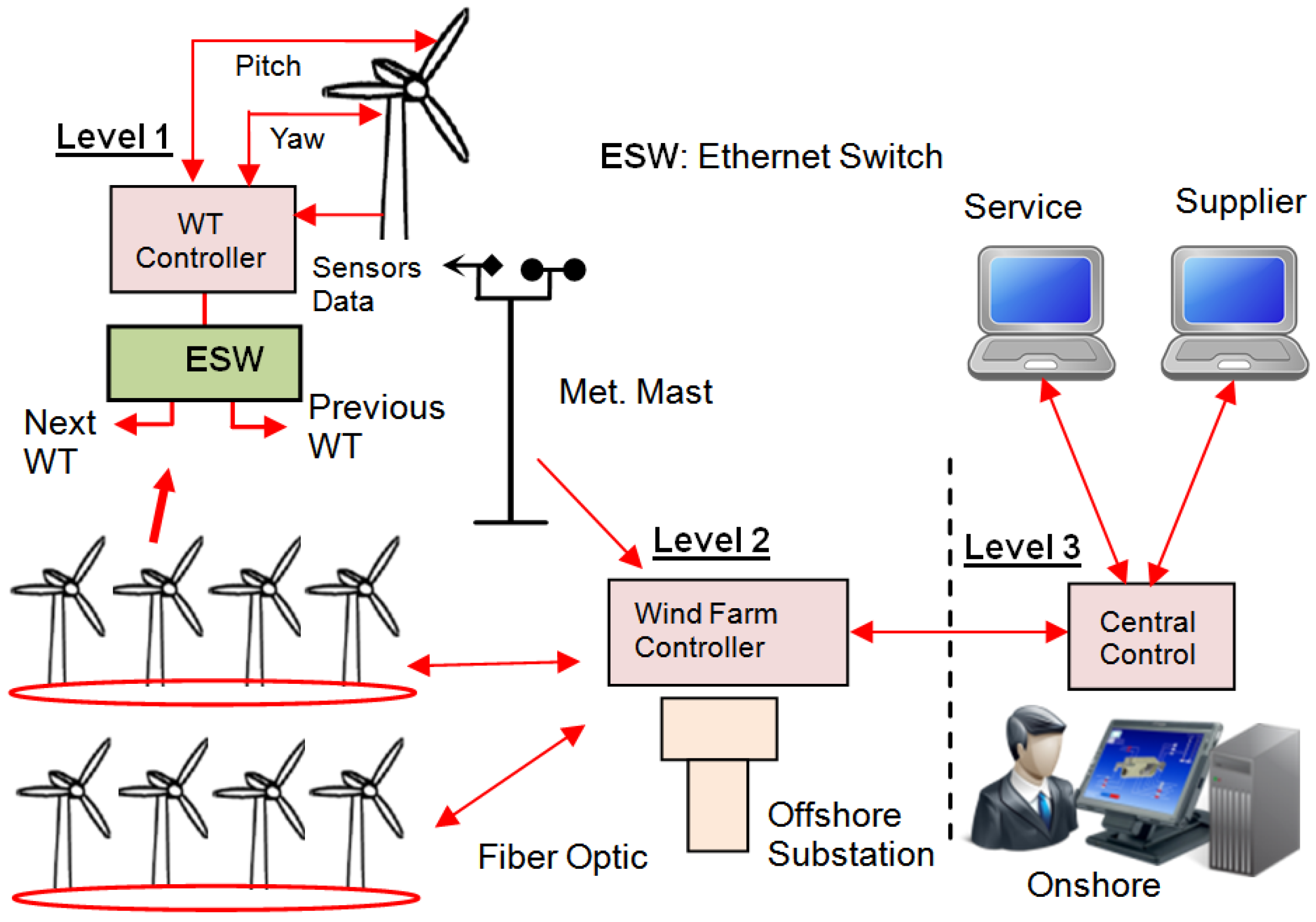
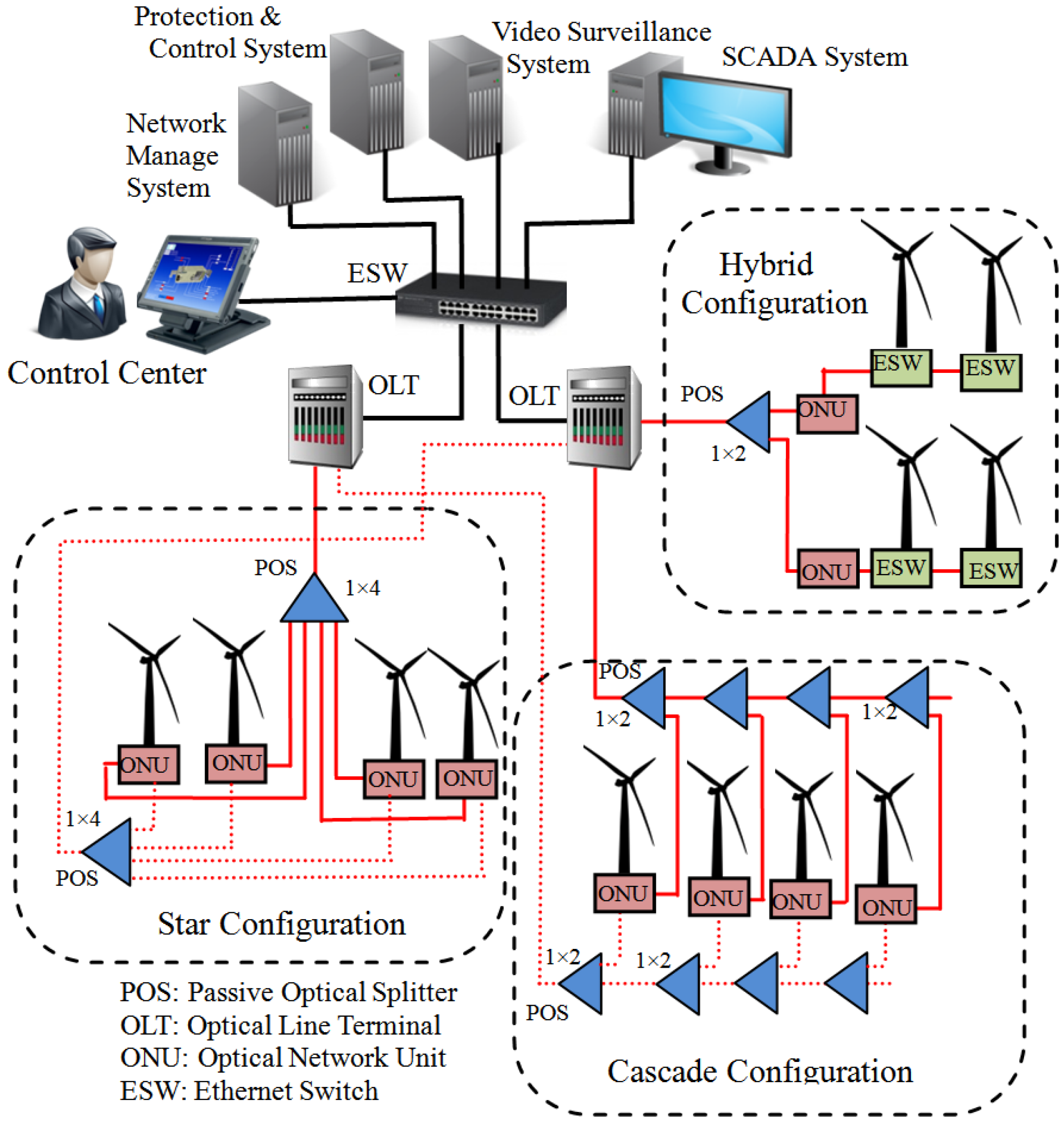

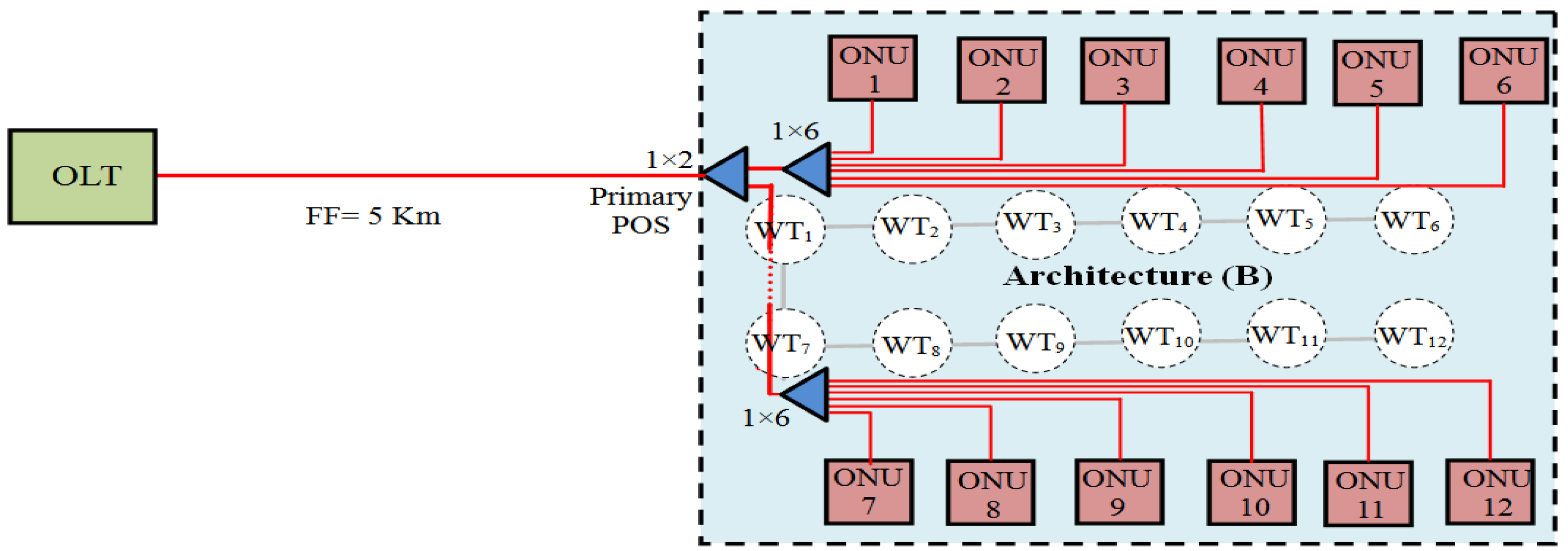


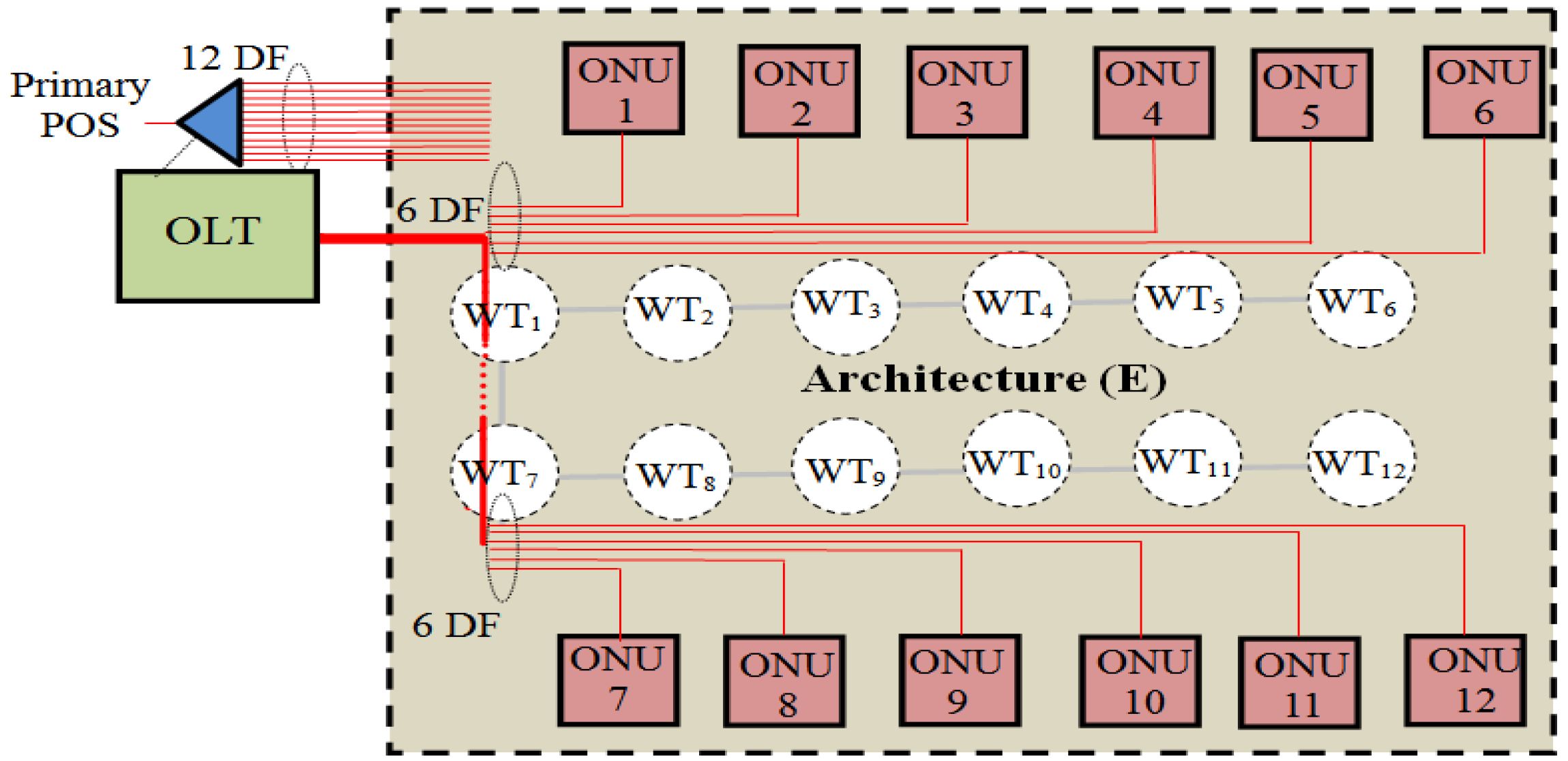





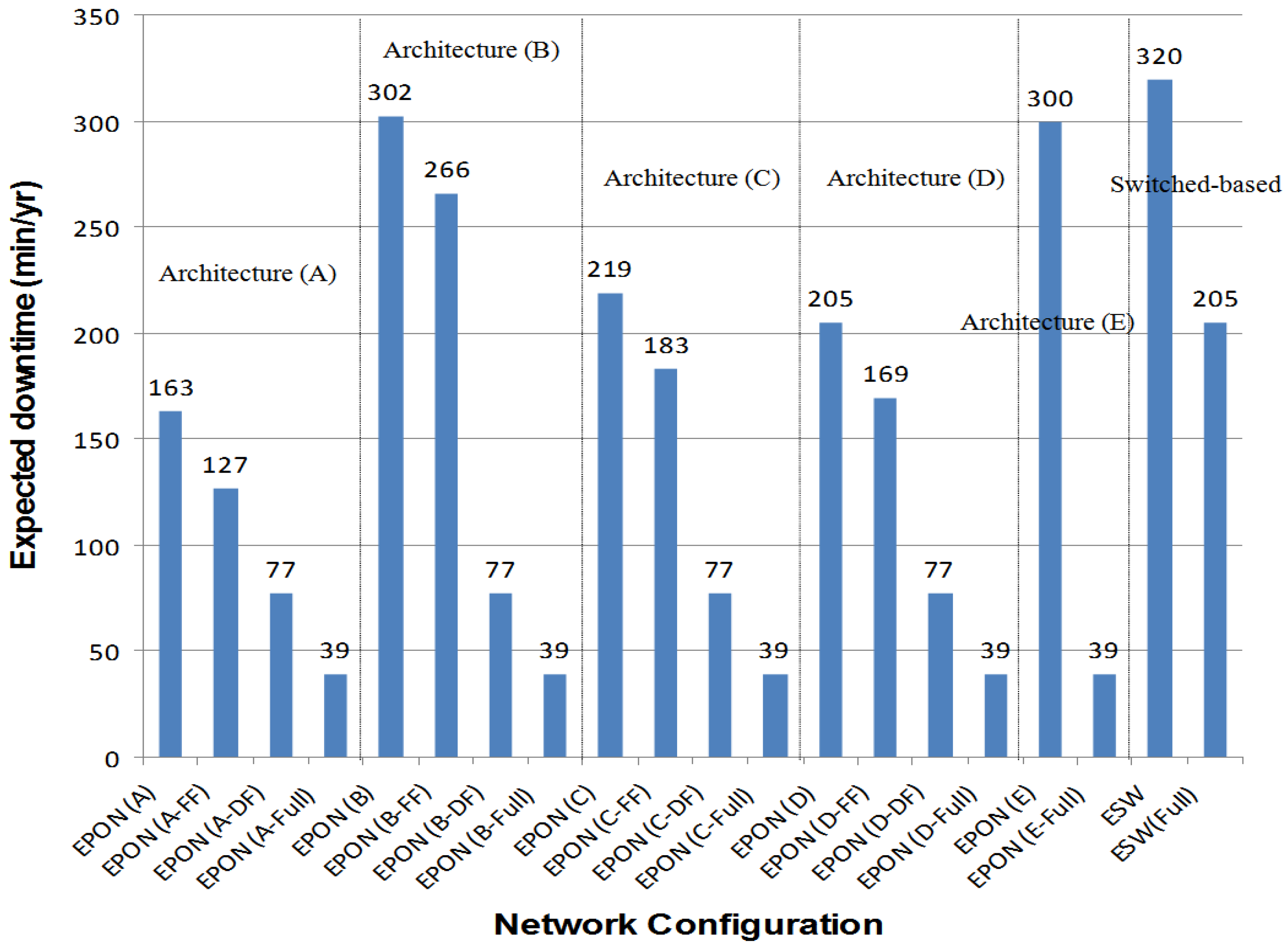
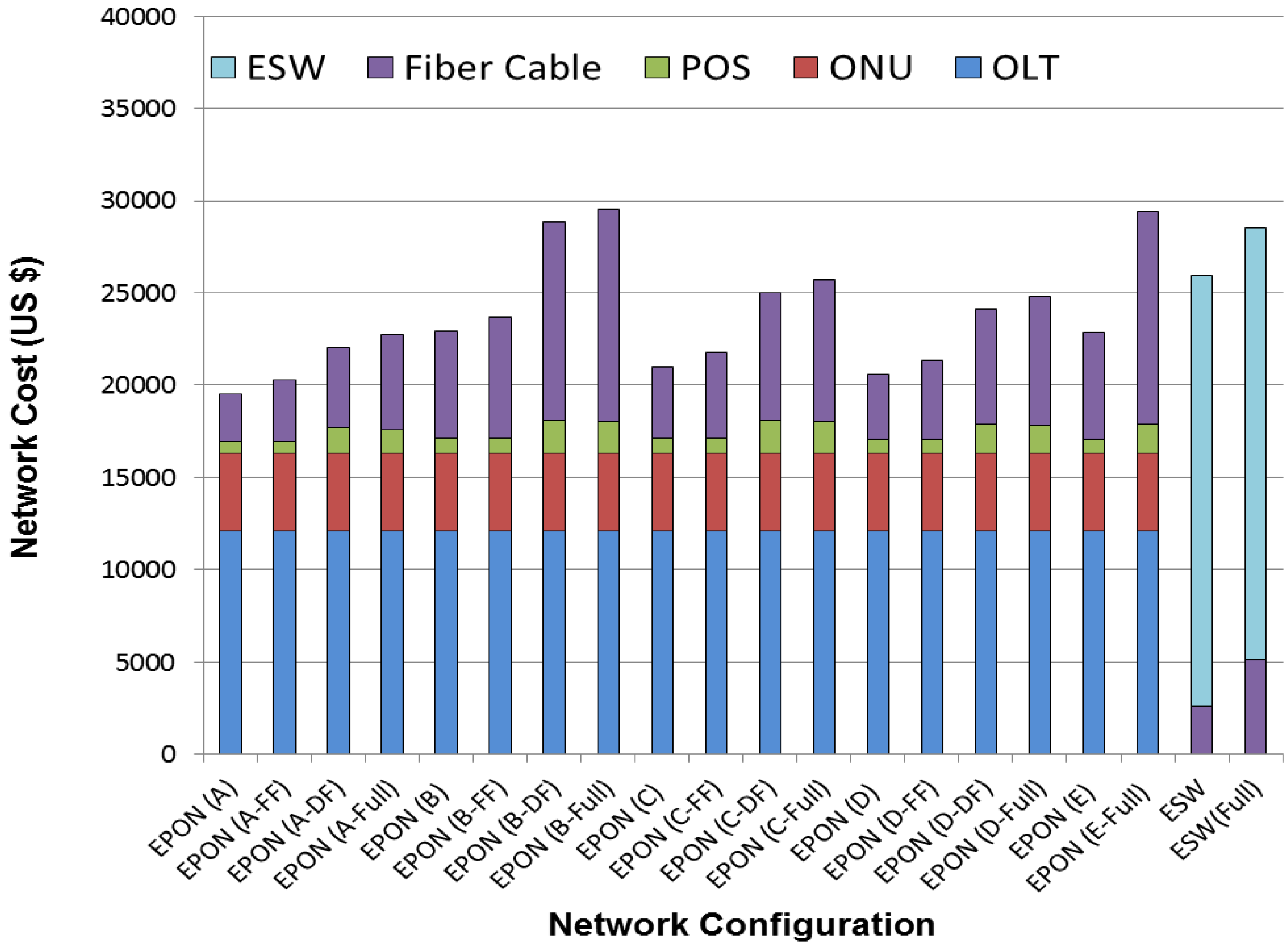
| EPON | OLT | FF (km) | Number Primary POS | Number Secondary POS | Number Other POS | DF (km) |
|---|---|---|---|---|---|---|
| A | 1 | 5 | 1 (1 × 2) | 12 (1 × 2) | - | 11 |
| B | 1 | 5 | 1 (1 × 2) | 2 (1 × 6) | - | 31 |
| C | 1 | 5 | 1 (1 × 2) | 4 (1 × 4) | - | 19 |
| D | 1 | 5 | 1 (1 × 2) | 2 (1 × 4) | 6 (1 × 2) | 17 |
| E | 1 | - | 1 (1 × 12) | - | - | 36 |
| Parameter | Data Rate | Power Budget |
|---|---|---|
| EPON | 1.25 Gbps (D and U) 1000Base-PX20 | PX-20U 26 dB PX-20D 26 dB |
| Component | Attenuation |
|---|---|
| Fiber | 0.4 dB/km |
| Connector | 0.2 dB |
| Splitter | 1 × 2 (5%:95%) ➔ 0.4 dB |
| 1 × 2 (50%:50%) ➔ 3.0 dB | |
| 1 × 4 ➔ 6.0 dB | |
| 1 × 8 ➔ 9.0 dB | |
| 1 × 16 ➔ 12.0 dB |
| Components | Failure Rate (FIT) * | MTTR (h) | Unavailability |
|---|---|---|---|
| OLT | 256 | 4 | 1.024 × 10−6 |
| ONU | 256 | 24 | 6.144 × 10−6 |
| Switch | 1250 | 24 | 3.00 × 10−5 |
| 1:2 Splitter | 50 | 24 | 1.20 × 10−6 |
| 1:N (2:N) Splitter | 120 | 24 6 | 2.88 × 10−6 7.20 × 10−7 |
| Fiber (per km) | 570/km | 24 | 1.368 × 10−5 |
| Parameter | Cost (US $) |
|---|---|
| OLT | 12100 |
| ONU | 350 |
| ESW | 1800 |
| Splitter (1 × 2) | 50 |
| Splitter (1 × N) | (50 per port) |
| Fiber (per km) | 160 |
© 2016 by the authors; licensee MDPI, Basel, Switzerland. This article is an open access article distributed under the terms and conditions of the Creative Commons by Attribution (CC-BY) license (http://creativecommons.org/licenses/by/4.0/).
Share and Cite
A. Ahmed, M.; Pan, J.-K.; Song, M.; Kim, Y.-C. Communication Network Architectures Based on Ethernet Passive Optical Network for Offshore Wind Power Farms. Appl. Sci. 2016, 6, 81. https://doi.org/10.3390/app6030081
A. Ahmed M, Pan J-K, Song M, Kim Y-C. Communication Network Architectures Based on Ethernet Passive Optical Network for Offshore Wind Power Farms. Applied Sciences. 2016; 6(3):81. https://doi.org/10.3390/app6030081
Chicago/Turabian StyleA. Ahmed, Mohamed, Jae-Kyung Pan, Minho Song, and Young-Chon Kim. 2016. "Communication Network Architectures Based on Ethernet Passive Optical Network for Offshore Wind Power Farms" Applied Sciences 6, no. 3: 81. https://doi.org/10.3390/app6030081






